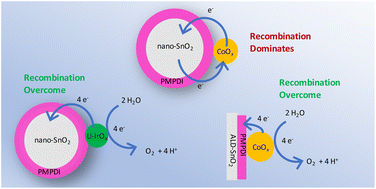Overcoming residual carbon-induced recombination in water-oxidation catalysis: combining a superior catalyst with low-carbon-content atomic layer deposition of SnO2 for improved catalysis†
Abstract
Previously an all earth-abundant dye-sensitized photoelectrochemical cell, composed of nanostructured SnO2 coated in perylene diimide dye (N,N′-bis(phosphonomethyl)-3,4,9,10-perylenediimide, PMPDI) plus photoelectrochemically deposited cobalt oxide (CoOx) catalyst, was shown to photoelectrochemically oxidize water. However, in that earlier work and device the addition of a known water-oxidation catalyst (WOCatalyst), CoOx, was found to reduce photocurrents, an effect that we termed an “anti-catalyst” effect to emphasize its unexpected, opposite-from-desired nature. The cause of the anti-catalyst effect was discovered to be residual carbon in the nanostructured SnO2 scaffolding necessary to increase surface area and photocurrents, hence actually residual-C-containing SnOxCy scaffolding. Herein, we examine two approaches to overcome this undesired anti-catalyst effect. First, we demonstrate photocurrent improvement with the addition of a more active, state-of-the-art, amorphous Li-IrOx, WOCatalyst. Second, we employ more phase-pure, planar SnO2 prepared by atomic layer deposition (ALD) and quantitatively compare, by optical absorption and double-layer capacitance measurements, the performance of ALD-SnO2vs. the nano-SnOxCy made in house following a literature recipe. The more phase-pure ALD-SnO2 yielded higher photocurrents based on either per dye or per electrochemically active surface area basis. Finally, in a third approach we combine both strategies for overcoming the anti-catalyst effect, specifically we use the best-in-class Li-IrOx catalyst and ALD-SnO2 to generate a best-performing device to date for this system. The results offer three successful approaches to overcome the anti-catalyst effect caused by residual-carbon-based recombination.

- This article is part of the themed collection: Recent Open Access Articles


 Please wait while we load your content...
Please wait while we load your content...